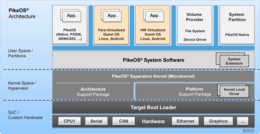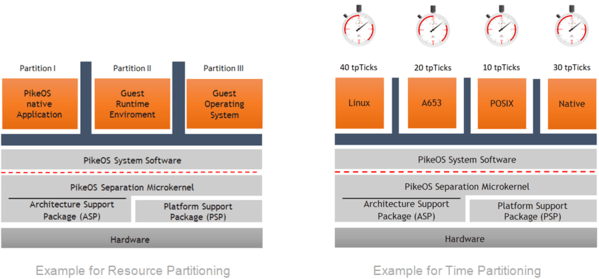PikeOS
| Developer | SYSGO AG |
|---|---|
| OS family | Real-time |
| Source model | Closed source |
| Latest release | 4.2 (April 2017) |
| Kernel type | Microkernel |
| Official website | https://www.sysgo.com/products/pikeos-hypervisor/ |
PikeOS is a commercial, hard real-time operating system (RTOS) that offers a separation kernel based hypervisor with multiple partition types for many other operating systems (called GuestOS) and applications. It enables users to build certifiable smart devices for the Internet of Things according to the high quality, safety and security standards of different industries.

Overview PikeOS
PikeOS combines a real-time operating system (RTOS) with a virtualization platform and Eclipse-based integrated development environment (IDE) for embedded systems. It is a commercial clone of L4 microkernel family[1]. The PikeOS real-time operating system has been developed for safety and security-critical applications with certification needs in the fields of Aerospace & Defense, Automotive & Transportation, Industrial Automation & Medical, Network Infrastructures and Consumer Electronics.
One of the key features of PikeOS is the capability to safely execute applications with different safety and security levels concurrently on the same platform. This is achieved by the strict spatial and temporal segregation of these applications by means of software partitions. A software partition can be seen as a container with pre-allocated privileges that can have access to memory, CPU time, I/O, but also a predefined list of PikeOS services. With PikeOS, the term application refers to an executable linked against the PikeOS API library and running as a process inside a partition. Due to the nature of the PikeOS API, applications can range from simple control loops up to complete Para virtualized guest operating systems like Linux or hardware virtualized guests.

Software partitions are also called Virtual Machines (VMs), because it is possible to implement a complete guest operating system inside a partition which executes independently from other partitions and therefore can address use cases with mixed criticality. PikeOS can be seen as a Type 1 Hypervisor.
Supported Toolchain / IDE CODEO
The Eclipse-based IDE CODEO supports system architects with graphical configuration tools, providing all the components that software engineers will need to develop embedded applications, as well as including comprehensive wizards to help embedded project development in a time-saving and cost-efficient way:
- guided configuration
- remote debugging (down to the hardware instruction level)
- target monitoring
- remote application deployment
- and timing analysis
Several dedicated graphical editing views are supporting the system integrator to always keep the overview on important aspects of the PikeOS system configuration showing partition types, scheduling, communication channels, shared memory and IO device configuration within partitions.
Projects can be easily defined with the help of reusable templates and distributed to the development groups. Users can configure pre-defined components for their project and can also define and add other components during the development process.
Key benefits of PikeOS
- Real Time Operating System including type 1 hypervisor defined for highly flexible configuration
- Supports fast or secure booting times
- Supporting mixed criticality via separation kernel in one system
- Configuration of partitions with time and hardware resources
- Kernel driver and user space drivers supported
- Hardware independence between processor types and families
- Easy migration processes and high portability on single- and multi-core
- Developed to support certification according to multiple safety & security standards
- Reduced time to market via standard development and verification tools
- Wide range of supported GuestOS types (APIs)
- No export restriction (European solution)
Certification standards
Safety certification standards according to
Security certification standards according to
- Common Criteria
- SAR
Partner Ecosystem
SYSGO is committed to establish the technological and business partnerships that will help software engineers to achieve their goals. SYSGO is currently working with about 100 partners worldwide.[2]
An excerpt of partners per category is mentioned below:
- Board Vendors: Curtiss-Wright Controls Embedded Computing, Kontron, MEN or ABACO
- Silicon Vendors: NXP, Renesas, TI, Xilinx, Infineon, NVidia or Intel
- Software Partners: CoreAVI, Aicas, AdaCore, Esterel, RTI, PrismTech, Datalight, Systerel, Imagination Technologies or RAPITA
- Tool Partners: Lauterbach, Vector Software, Rapita, iSystem
- Supported Architectures: ARM, PPC, X86 or Sparc (on request)
Supported GuestOS types
End-of-Life Overview PikeOS

References
- ↑ http://ts.data61.csiro.au/publications/nicta_full_text/8988.pdf
- ↑ "Partner Directory - SYSGO - Embedding Innovations". www.sysgo.com. Retrieved 12 October 2017.